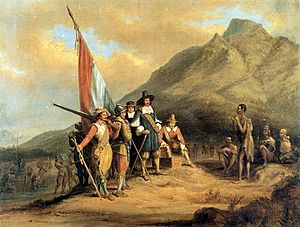History of South Africa (1652–1815) facts for kids
Long ago, Portuguese sailors were the first Europeans to successfully sail around the southern tip of Africa. Even though this was a big achievement, they weren't very interested in settling there. The strong winds and rocky coastline made it dangerous for their ships. Also, their attempts to trade with the local Khoikhoi people often led to fights. The Portuguese found the coast of Mozambique more appealing, with better bays and links to gold.
The Portuguese didn't have much competition in this area until the late 1500s. That's when the English and Dutch began to challenge them on their trade routes. More ships started stopping at the southern tip of Africa. The Cape became a regular stop for sailors who were sick with scurvy, a disease caused by a lack of vitamin C.
In 1647, a Dutch ship called the Haarlem was wrecked in what is now Table Bay. After being rescued, the crew suggested that a permanent station should be built there. The Dutch East India Company (VOC), a major European trading company that sailed the spice route to the East, didn't plan to colonize the area. They just wanted a safe base where passing ships could get fresh supplies like meat, fruit, and vegetables. To do this, a small VOC group led by Jan van Riebeeck arrived at Table Bay on April 6, 1652. The Cape was under Dutch rule from 1652 to 1795, and again from 1803 to 1806.
The Dutch Arrive in South Africa

The new Dutch settlement traded with the nearby Khoikhoi people when needed. However, their relationship was often difficult, and the Dutch leaders tried to limit contact. Because of this, the VOC workers faced a shortage of people to do the work. To solve this, they allowed a small number of Dutch workers to leave their contracts and start their own farms. These farmers would then supply the VOC settlement with their harvests.
This plan worked very well! The farms produced lots of fruit, vegetables, wheat, and wine. Later, they also raised animals. This first group of farmers, known as "free burghers," grew steadily. They began to expand their farms further north and east, moving into the land of the Khoikhoi.
Most of these farmers were of Dutch background and belonged to the Calvinist Reformed Church of the Netherlands. But there were also many Germans and some people from Scandinavia. In 1688, French Huguenots joined the Dutch and Germans. The Huguenots were also Calvinists who were escaping religious persecution under King Louis XIV in France.
Besides creating the free burgher system, Jan van Riebeeck and the VOC also started using Khoikhoi and San people as servants. They also began bringing in many slaves, mostly from Madagascar and Indonesia. These slaves often married Dutch settlers. Their descendants became known as the Cape Coloureds and the Cape Malays. Many children born from unions between White settlers and slaves became part of the local White population who spoke an early form of Afrikaans.
With more workers, the areas controlled by the VOC grew further north and east. This led to unavoidable clashes with the Khoikhoi. The newcomers forced the Khoikhoi from their traditional lands. When the Khoikhoi fought back, the Europeans used their better weapons to defeat them. There were several major wars and guerrilla resistance movements that continued into the 1800s. Europeans also brought diseases that had terrible effects on people whose bodies were not used to them. Most survivors had no choice but to work for the Europeans under very difficult conditions, similar to slavery. Over time, the Khoisan people, their European supervisors, and the imported slaves mixed. The children of these unions formed the basis for today's Coloured population.
One well-known Khoikhoi group was the Griqua. They originally lived on the western coast between St Helena Bay and the Cederberg Range. In the late 1700s, they managed to get guns and horses and began moving northeast. Other groups of Khoisan, people of mixed backgrounds, and even white adventurers joined them along the way. They quickly became known as a strong military force. Eventually, the Griquas reached the Highveld, near where Kimberley is today. There, they created their own territory, which became known as Griqualand.
Farmers Expand Their Land
As the farmers, called burghers, continued to move into the rugged areas of the north and east, many started living a semi-nomadic life, much like the Khoikhoi they had replaced. Besides their herds of animals, a family might have a wagon, a tent, a Bible, and a few guns. As they settled down more, they would build a mud-walled cottage. They often chose to live days of travel from the nearest European settlement.
These were the first of the Trekboere (Wandering Farmers, later shortened to Boers). They were completely independent of official rules, very self-sufficient, and lived isolated lives. Their tough lifestyle created strong individuals who knew the land very well. Like many pioneers with Christian backgrounds, the burghers tried to live their lives based on teachings from the Bible.

